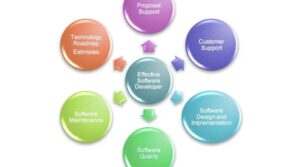In today’s evolving work landscape, hybrid work models—where employees split their time between remote and in-office work—are becoming increasingly common. This shift presents unique challenges and opportunities for cultivating a strong company culture. Building and maintaining a cohesive and engaged workforce in a hybrid environment requires intentional strategies and a commitment to fostering connections. In this article, we’ll explore key strategies for building a strong company culture in a hybrid work environment, including practical tips and best practices.
Table of Contents
Understanding Hybrid Work Environments
A hybrid work environment typically involves a combination of in-office and remote work. This model allows employees to enjoy the flexibility of working from home while also benefiting from the social interactions and collaborative opportunities provided by the office. However, this setup can create challenges in maintaining a unified company culture, as employees may have different experiences and levels of engagement depending on their work location.
Key Strategies for Building a Strong Company Culture in a Hybrid Environment
1. Define and Communicate Core Values
A strong company culture begins with clearly defined core values. These values should guide behavior, decision-making, and interactions within the company. In a hybrid work environment, it’s crucial to regularly communicate these values through various channels to ensure that all employees, regardless of their location, understand and embrace them.
Actionable Tips:
- Incorporate core values into company communications, such as newsletters and team meetings.
- Create a values-oriented onboarding process for new hires.
- Share success stories that exemplify company values in action.
2. Foster Regular Communication
Effective communication is the backbone of a strong company culture, especially in a hybrid setting. Regular and transparent communication helps bridge the gap between remote and in-office employees and ensures that everyone feels connected and informed.
Actionable Tips:
- Use a variety of communication tools, such as video calls, chat platforms, and email, to keep everyone connected.
- Schedule regular team meetings and one-on-one check-ins to maintain engagement.
- Encourage open feedback and create channels for employees to voice concerns or suggestions.
3. Promote Inclusivity and Team Building
In a hybrid work environment, it’s essential to ensure that all employees feel included and valued, regardless of their work location. Team-building activities can help strengthen relationships and build a sense of camaraderie among team members.
Actionable Tips:
- Organize virtual team-building activities, such as online games or trivia contests.
- Host occasional in-person events or gatherings to bring together remote and in-office employees.
- Ensure that all team members, whether remote or on-site, have equal opportunities to participate in projects and meetings.
4. Leverage Technology for Collaboration
Technology plays a crucial role in facilitating collaboration and maintaining company culture in a hybrid work environment. By using the right tools and platforms, companies can enhance communication and collaboration among team members.
Actionable Tips:
- Invest in collaboration tools, such as project management software and video conferencing platforms.
- Ensure that all employees are trained to use these tools effectively.
- Create guidelines for virtual meetings to ensure they are productive and inclusive.
5. Encourage Work-Life Balance
One of the advantages of hybrid work is the ability to achieve a better work-life balance. Supporting employees in maintaining this balance can contribute to a positive company culture and improve overall job satisfaction.
Actionable Tips:
- Promote flexible work schedules and encourage employees to set boundaries between work and personal life.
- Offer resources and support for mental health and well-being.
- Recognize and celebrate achievements and milestones to boost morale.
6. Lead by Example
Leadership plays a critical role in shaping and maintaining company culture. Leaders should model the behavior and values they wish to see in their employees, demonstrating a commitment to the company’s culture and values.
Actionable Tips:
- Be transparent and approachable in your communication with employees.
- Actively participate in team-building activities and demonstrate a commitment to inclusivity.
- Provide regular feedback and support to help employees succeed in a hybrid environment.
7. Measure and Adapt
Building a strong company culture is an ongoing process that requires regular assessment and adaptation. By measuring the effectiveness of your strategies and being open to change, you can continuously improve your company culture.
Actionable Tips:
- Conduct employee surveys to gather feedback on company culture and identify areas for improvement.
- Monitor key metrics, such as employee engagement and retention rates, to assess the impact of your culture-building efforts.
- Be willing to adjust your strategies based on feedback and changing circumstances.
FAQs
Q: How can I ensure that remote employees feel as included as in-office employees?
A: To ensure remote employees feel included, focus on regular communication, provide equal opportunities for participation, and involve them in team-building activities. Use technology to bridge the gap and create an environment where all team members can contribute and feel valued.
Q: What are some effective virtual team-building activities?
A: Effective virtual team-building activities include online games, virtual escape rooms, trivia contests, and collaborative projects. These activities can help strengthen relationships and foster a sense of camaraderie among remote team members.
Q: How can I measure the success of my company culture initiatives in a hybrid environment?
A: Measure the success of your company culture initiatives by conducting employee surveys, tracking engagement and retention rates, and monitoring feedback. Regularly assess the impact of your efforts and be open to making adjustments as needed.
Q: What role does leadership play in shaping company culture in a hybrid work environment?
A: Leadership plays a crucial role in shaping company culture by modeling desired behaviors, communicating core values, and actively participating in culture-building activities. Leaders should demonstrate a commitment to inclusivity and support employees in maintaining a positive work environment.
Q: How can I support employees in achieving work-life balance in a hybrid setting?
A: Support employees in achieving work-life balance by promoting flexible work schedules, encouraging boundaries between work and personal life, and offering resources for mental health and well-being. Recognize and celebrate achievements to boost morale and job satisfaction.
Conclusion
Building a strong company culture in a hybrid work environment requires a thoughtful approach and a commitment to fostering connections and inclusivity. By defining core values, promoting regular communication, leveraging technology, and supporting work-life balance, companies can create a cohesive and engaged workforce. Leadership plays a pivotal role in modeling desired behaviors and maintaining a positive culture, while regular assessment and adaptation ensure that culture-building efforts remain effective. Embracing these strategies can help organizations thrive in the evolving world of hybrid work.



